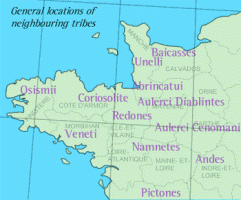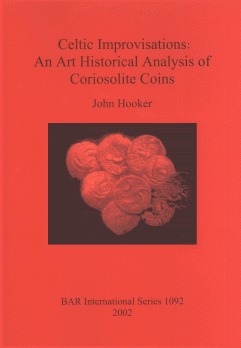My name is John Hooker and I have researched, written and published on the ancient Celts, their coinage, religion and art for a very long time. My first publication was Notes on part of the Le Catillon hoard purchased by the Société Jersiaise in 1989 Ann. Bull. Soc. Jersiaise, 1993, 26 (1). I still have a number of off-prints -- would anyone like one? They say that an author's first publication is often worth more to a collector than subsequent publications. In my case, I am sure that this is not true. I would forgive anyone for not having read it, knowing what it was about, or even knowing that it was published in the Bailiwick of Jersey, in the Channel Islands (U.K.)

The article was about a hoard of coins, about 30% being of the Coriosolite tribe minted during Caesar's conquest of Gaul, but buried some time later. I compared the selection purchased by the Société to the profile of the hoard, itself. Even back then, I thought that it was hardly worthwhile publishing anything unless you had something new to say. I had rather a lot of new information to show the world. For a start, not all of the coins that were believed to be Coriosolite were of that tribe -- they were of a tribe called the Unelli. I also said that the hoards of coins found in Jersey were not buried by refugees fleeing from the Romans as was often (but not always) thought, but were essentially scrap metal buried after the war that was destined for recycling at Hengistbury, on the south coast of England.
I had created (1986) a new taxonomy separating the evolutionary changes from arbitrary changes in hundreds of design elements in the die creation and had plotted the former in a cladistic structure of flow-chart design, replacing the old system of die linking the die products which had used only a few arbitrarily chosen elements to establish a rudimentary and inaccurate classification system of six classes. The new system revealed three different issues, and hitherto unknown and occluded geographical details. Gilding the lily, I also broke them down into fifteen groups just for ease of identification and created a paper expert system by which a child could catalog any coin in a minute or two. Later (1996), I converted this to a web application complete with hyperlinks to essays about various themes at different stages of the system. A PhD student at Hofstra featured the latter in her thesis.
Nineteen years later, another hoard has been discovered, very close to the hoard I had written about in my first publication, and apparently of a similar composition. All of the reports, so far have again attributed the hoard to Coriosolites fleeing from Caesar's troops. I was not the only person to suggest that Le Catillon was later than the Gallic war. Colin Haselgrove had also thought that it was post-Caesar in the late eighties, while I was researching and working on my manuscript: Celtic Improvisations: An Art Historical Analysis of Coriosolite Coins . Of course, my publication of 1989 was obscure, and Haselgrove was mainly working on the coins of S.E. England so it is little surprise that the idea had not spread far. After Spink turned down the manuscript because it was too specialized for commercial publication, I published it on the web, for free, in 2000.
Of course, there is a lot of nonsense on the web, and just because I had written something there, there is no reason that it should be taken at face value. However, almost at once, the web version was spotted by the archaeologist Sean Kingsley, who at that time was the managing editor for Minerva Magazine in London. He asked me to write a piece about my research and it was published as Celtic Improvisations: The Coins of the Coriosolites in volume 13 number 1 (2002). Being a commercial publication, it was not noticed by academia in general, and it was based on another hoard, so again, the information slipped by, unnoticed outside of the magazine's readership.
Sean told me that the book should really be in hard copy, and he made a couple of phone calls -- the outcome of which was that it was published, that very year, in British Archaeological Reports, BAR International Series (1092), Oxford. I was very happy about that as I had made great use of the BAR Series in my research. It contained top notch research and was commonly ordered, by subscription, by most university libraries. I only got ten copies for my efforts, but was happy to be in such good company. But, as books became more expensive, and the economy declined, most university libraries could not afford to subscribe to that series anymore and, instead, just ordered the titles that fitted with their own areas of interest.
I was invited, by Professor Raimund Karl, to supply the entry for Celtic coinage in John Koch's five volume
Celtic Culture A Historical Encyclpaedia and this set was published in 2005. Being such a monumental work, the authors could not possibly be paid, but were able to buy the set at half price from the publisher.
I uploaded the hard copy version of Celtic Improvisations to Academia.edu, where it became a little more visible to the public as it was appearing on Google. Membership was free and the public could sign in as independent scholars. A number of people downloaded it, but even my local university library did not carry the actual hard copy on their shelves.
Rather than waste my time with further academic publications, which are useful to produce only for those within that system, but of no use at all to independent scholars, and the public at large, I thought it might be a nice idea to go directly to the public, so this blog will have current research that is ongoing, and will be about a number of topics. There will also be links to an e-book or two that I will publish at a price that anyone can afford; perhaps a few guest spots from the cream of academia, and elsewhere; good friends, anecdotes and issues far removed from Celtic coins and Celtic art-- artistic, environmental, social, and just mundane but interesting stuff. Something for everyone. You never know what, or who, you might encounter here. Perhaps this is the way of the future!
John Hooker
